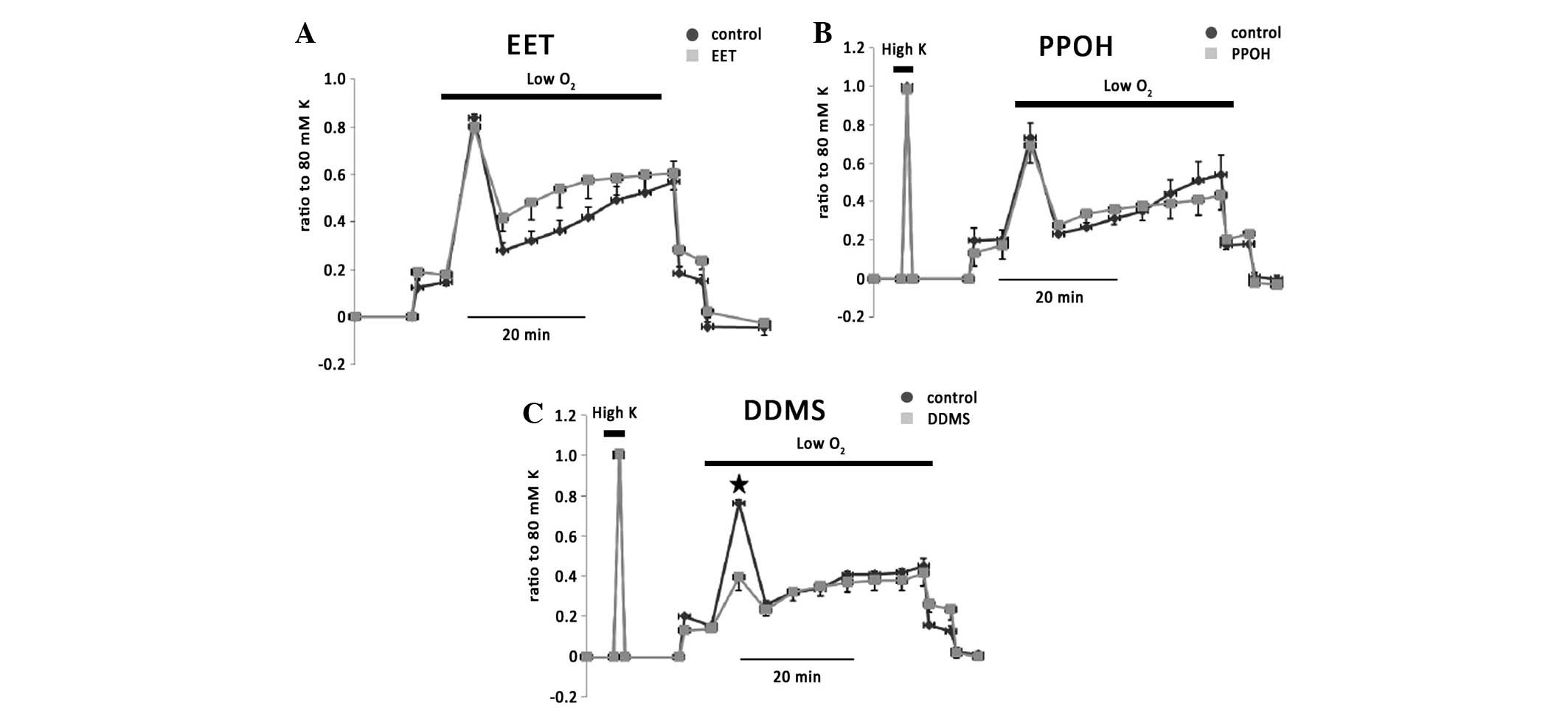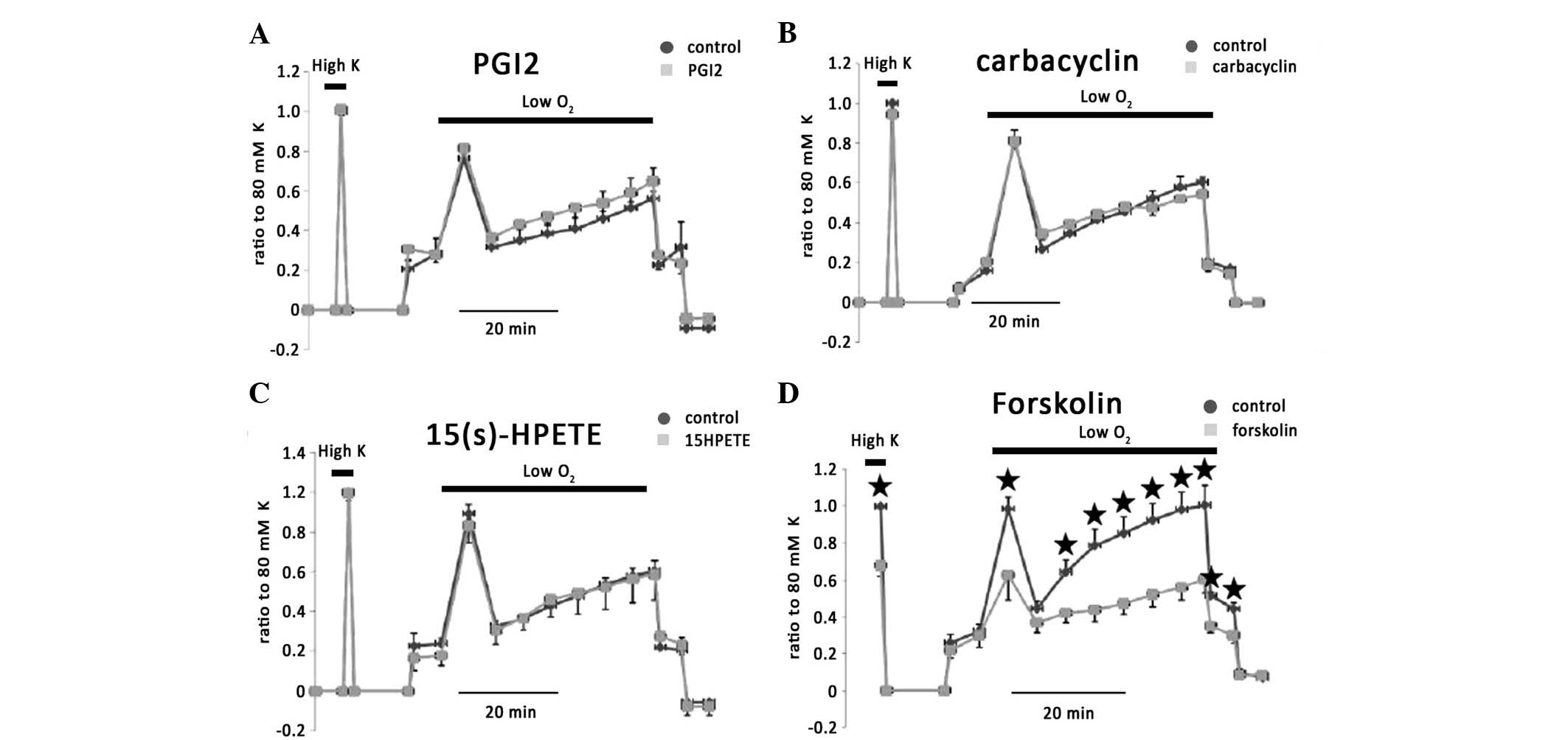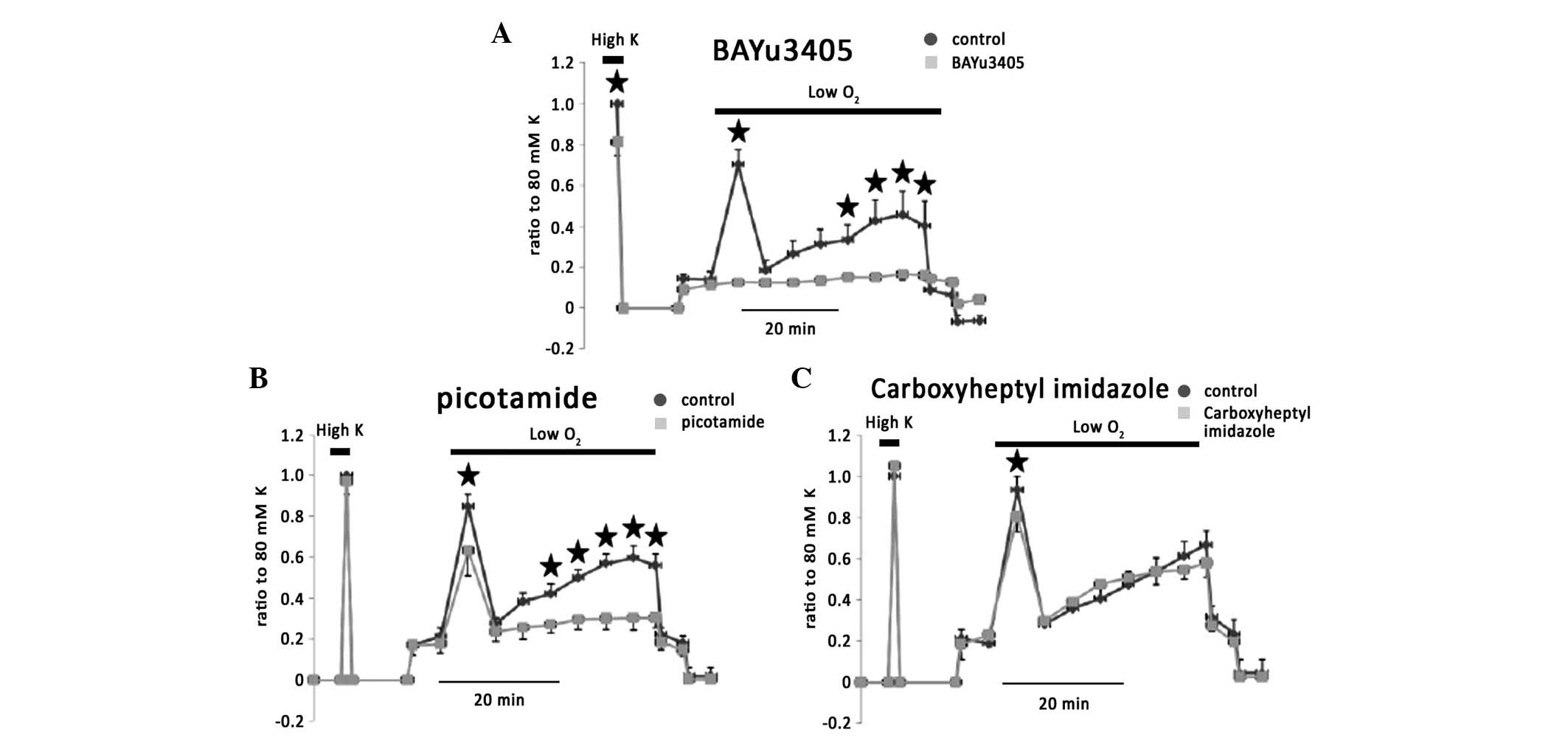|
1
|
Sommer N, Dietrich A, Schermuly RT, et al:
Regulation of hypoxic pulmonary vasoconstriction: basic mechanisms.
Eur Respir J. 32:1639–1651. 2008. View Article : Google Scholar : PubMed/NCBI
|
|
2
|
Moudgil R, Michelakis ED and Archer SL:
Hypoxic pulmonary vasoconstriction. J Appl Physiol. 98:390–403.
2005. View Article : Google Scholar
|
|
3
|
Norel X: Prostanoid receptors in the human
vascular wall. Scientific World Journal. 7:1359–1374. 2007.
View Article : Google Scholar : PubMed/NCBI
|
|
4
|
Pokreisz P, Fleming I, Kiss L, et al:
Cytochrome P450 epoxygenase gene function in hypoxic pulmonary
vasoconstriction and pulmonary vascular remodeling. Hypertension.
47:762–770. 2006. View Article : Google Scholar : PubMed/NCBI
|
|
5
|
Dhanasekaran A, Al-Saghir R, Lopez B, et
al: Protective effects of epoxyeicosatrienoic acids on human
endothelial cells from the pulmonary and coronary vasculature. Am J
Physiol Heart Circ Physiol. 291:H517–H531. 2006. View Article : Google Scholar
|
|
6
|
Frazziano G, Moreno L, Moral-Sanz J, et
al: Neutral sphingomyelinase, NADPH oxidase and reactive oxygen
species. Role in acute hypoxic pulmonary vasoconstriction. J
Cellular Physiol. 226:2633–2640. 2011. View Article : Google Scholar
|
|
7
|
Meng F, To WK and Gu Y: Inhibition effect
of arachidonic acid on hypoxia-induced [Ca(2+)](i) elevation in
PC12 cells and human pulmonary artery smooth muscle cells. Respir
Physiol Neurobiol. 162:18–23. 2008.
|
|
8
|
Harteneck C: Function and pharmacology of
TRPM cation channels. Naunyn Schmiedebergs Arch Pharmacol.
371:307–314. 2005. View Article : Google Scholar : PubMed/NCBI
|
|
9
|
Grimm C, Kraft R, Schultz G and Harteneck
C: Activation of the melastatin-related cation channel TRPM3 by
D-erythro-sphingosine [corrected]. Mol Pharmacol. 67:798–805.
2005.PubMed/NCBI
|
|
10
|
Fleming I: Epoxyeicosatrienoic acids, cell
signaling and angiogenesis. Prostaglandins Other Lipid Mediat.
82:60–67. 2007. View Article : Google Scholar : PubMed/NCBI
|
|
11
|
Llinás MT, Alexander BT, Capparelli MF,
Carroll MA and Granger JP: Cytochrome P-450 inhibition attenuates
hypertension induced by reductions in uterine perfusion pressure in
pregnant rats. Hypertension. 43:623–628. 2004.PubMed/NCBI
|
|
12
|
Larsen BT, Gutterman DD, Sato A, et al:
Hydrogen peroxide inhibits cytochrome p450 epoxygenases:
interaction between two endothelium-derived hyperpolarizing
factors. Circ Res. 102:59–67. 2008. View Article : Google Scholar
|
|
13
|
Naik JS and Walker BR: Role of vascular
heme oxygenase in reduced myogenic reactivity following chronic
hypoxia. Microcirculation. 13:81–88. 2006. View Article : Google Scholar : PubMed/NCBI
|
|
14
|
Zhang L, Cui Y, Geng B, Zeng X and Tang C:
11,12-Epoxyeicosatrienoic acid activates the L-arginine/nitric
oxide pathway in human platelets. Mol Cell Biochem. 308:51–56.
2008. View Article : Google Scholar : PubMed/NCBI
|
|
15
|
Hercule HC, Schunck WH, Gross V, et al:
Interaction between P450 eicosanoids and nitric oxide in the
control of arterial tone in mice. Arterioscler Thromb Vasc Biol.
29:54–60. 2009. View Article : Google Scholar : PubMed/NCBI
|
|
16
|
Gao Y, Feng J, Ma K, et al:
8,9-Epoxyeicosatrienoic acid inhibits antibody production of B
lymphocytes in mice. PLoS One. 7:e402582012. View Article : Google Scholar : PubMed/NCBI
|
|
17
|
Kiss L, Schütte H, Padberg W, et al:
Epoxyeicosatrienoates are the dominant eicosanoids in human lungs
upon microbial challenge. Eur Respir J. 36:1088–1098. 2010.
View Article : Google Scholar : PubMed/NCBI
|
|
18
|
Li Y, Connolly M, Nagaraj C, et al:
Peroxisome proliferator-activated receptor-β/δ, the acute signaling
factor in prostacyclin-induced pulmonary vasodilation. Am J Respir
Cell Mol Biol. 46:372–379. 2012.
|
|
19
|
Alvarez-Medina DI, Hernandez A and Orozco
C: Endothelial hyperpolarizing factor increases
acetylcholine-induced vasodilatation in pulmonary hypertensive
broilers arterial rings. Res Vet Sci. 92:1–6. 2012. View Article : Google Scholar
|
|
20
|
Liu Y, Wang R, Li J, et al: Stable EET
urea agonist and soluble epoxide hydrolase inhibitor regulate rat
pulmonary arteries through TRPCs. Hypertens Res. 34:630–639. 2011.
View Article : Google Scholar : PubMed/NCBI
|
|
21
|
Jacobs ER, Bodiga S, Ali I, et al: Tissue
protection and endothelial cell signaling by 20-HETE analogs in
intact ex vivo lung slices. Exp Cell Res. 318:2143–2152. 2012.
View Article : Google Scholar : PubMed/NCBI
|
|
22
|
Chawengsub Y, Gauthier KM and Campbell WB:
Role of arachidonic acid lipoxygenase metabolites in the regulation
of vascular tone. Am J Physiol Heart Circ Physiol. 297:H495–H507.
2009. View Article : Google Scholar : PubMed/NCBI
|
|
23
|
Michaelis UR, Xia N, Barbosa-Sicard E,
Falck JR and Fleming I: Role of cytochrome P450 2C epoxygenases in
hypoxia-induced cell migration and angiogenesis in retinal
endothelial cells. Invest Ophthalmol Vis Sci. 49:1242–1247. 2008.
View Article : Google Scholar : PubMed/NCBI
|
|
24
|
Higashimori H, Blanco VM, Tuniki VR, Falck
JR and Filosa JA: Role of epoxyeicosatrienoic acids as autocrine
metabolites in glutamate-mediated K+ signaling in
perivascular astrocytes. Am J Physiol Cell Physiol.
299:C1068–C1078. 2010. View Article : Google Scholar : PubMed/NCBI
|
|
25
|
Ayajiki K, Fujioka H, Toda N, et al:
Mediation of arachidonic acid metabolite(s) produced by endothelial
cytochrome P-450 3A4 in monkey arterial relaxation. Hypertens Res.
26:237–243. 2003. View Article : Google Scholar : PubMed/NCBI
|
|
26
|
Gebremedhin D, Yamaura K and Harder DR:
Role of 20-HETE in the hypoxia-induced activation of
Ca2+-activated K+ channel currents in rat
cerebral arterial muscle cells. Am J Physiol Heart Circ Physiol.
294:H107–H120. 2008. View Article : Google Scholar : PubMed/NCBI
|
|
27
|
Robertson TP, Hague D, Aaronson PI and
Ward JP: Voltage-independent calcium entry in hypoxic pulmonary
vasoconstriction of intrapulmonary arteries of the rat. J Physiol.
525:669–680. 2000. View Article : Google Scholar : PubMed/NCBI
|
|
28
|
Meng F, To WK and Gu Y: Role of TRP
channels and NCX in mediating hypoxia-induced [Ca2+](i)
elevation in PC12 cells. Respir Physiol Neurobiol. 164:386–393.
2008.PubMed/NCBI
|
|
29
|
Fleming I and Busse R: Endothelium-derived
epoxyeicosatrienoic acids and vascular function. Hypertension.
47:629–633. 2006. View Article : Google Scholar : PubMed/NCBI
|
|
30
|
Morales-Blanhir J, Santos S, de Jover L,
et al: Clinical value of vasodilator test with inhaled nitric oxide
for predicting long-term response to oral vasodilators in pulmonary
hypertension. Respir Med. 98:225–234. 2004. View Article : Google Scholar : PubMed/NCBI
|
|
31
|
Cyphert JM, Allen IC, Church RJ, et al:
Allergic inflammation induces a persistent mechanistic switch in
thromboxane-mediated airway constriction in the mouse. Am J Physiol
Lung Cell Mol Physiol. 302:L140–L151. 2012. View Article : Google Scholar : PubMed/NCBI
|
|
32
|
Baliga RS, Milsom AB, Ghosh SM, et al:
Dietary nitrate ameliorates pulmonary hypertension: cytoprotective
role for endothelial nitric oxide synthase and xanthine
oxidoreductase. Circulation. 125:2922–2932. 2012. View Article : Google Scholar
|
|
33
|
Kästner SB, Kull S, Kutter AP, Boller J,
Bettschart-Wolfensberger R and Huhtinen MK: Cardiopulmonary effects
of dexmedetomidine in sevoflurane-anesthetized sheep with and
without nitric oxide inhalation. Am J Vet Res. 66:1496–1502.
2005.PubMed/NCBI
|
|
34
|
Wunderlich C, Schmeisser A, Heerwagen C,
et al: Chronic NOS inhibition prevents adverse lung remodeling and
pulmonary arterial hypertension in caveolin-1 knockout mice. Pulm
Pharmacol Ther. 21:507–515. 2008. View Article : Google Scholar : PubMed/NCBI
|
|
35
|
Schwenke DO, Pearson JT, Tsuchimochi H,
Kangawa K and Shirai M: Pulmonary vascular reactivity of
spontaneously hypertensive rats is exacerbated in response to the
central administration of exogenous nitric oxide. Clin Exp
Pharmacol Physiol. 34:88–94. 2007. View Article : Google Scholar
|
|
36
|
Schwenke DO, Pearson JT, Mori H and Shirai
M: Does central nitric oxide elicit pulmonary hypertension in
conscious rats? Respir Physiol Neurobiol. 153:250–260. 2006.
View Article : Google Scholar : PubMed/NCBI
|


















